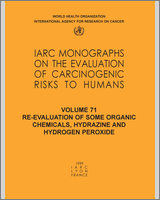NCBI Bookshelf. A service of the National Library of Medicine, National Institutes of Health.
IARC Working Group on the Evaluation of Carcinogenic Risks to Humans. Re-evaluation of Some Organic Chemicals, Hydrazine and Hydrogen Peroxide. Lyon (FR): International Agency for Research on Cancer; 1999. (IARC Monographs on the Evaluation of Carcinogenic Risks to Humans, No. 71.)
Data were last evaluated in IARC (1990).
1. Exposure Data
1.1. Chemical and physical data
1.1.1. Nomenclature
- Chem. Abstr. Serv. Reg. No.: 868-85-9
- Chem. Abstr. Name: Dimethyl phosphonate
1.1.2. Structural and molecular formulae and relative molecular mass

1.1.3. Physical properties (for details, see IARC, 1990)
- (a) Boiling point: 170–17°C at 2.6 kPa
- (b) Conversion factor: mg/m3 = 4.52 × ppm
1.2. Production, use and human exposure
Dimethyl hydrogen phosphite is used as a flame retardant on nylon 6 fibres, as a chemical intermediate in the production of pesticides and in lubricant additives and adhesives. No data on occupational exposure levels were available. A potential source of exposure to this chemical is from its occurrence as a degradation product of the chemical intermediate trimethyl phosphite and of pesticides such as trichlorphon and malathion (IARC, 1990).
2. Studies of Cancer in Humans
No data were available to the Working Group.
3. Studies of Cancer in Experimental Animals
Dimethyl hydrogen phosphite was tested for carcinogenicity by oral administration in one strain of mice and in one strain of rats. In rats, it caused an increase in the incidence of alveolar/bronchiolar carcinomas in animals of each sex and of squamous-cell carcinomas of the lung and of papillomas and carcinomas of the forestomach in males (IARC, 1990).
4. Other Data Relevant to an Evaluation of Carcinogenicity and its Mechanisms
4.1. Absorption, distribution, metabolism and excretion
No data were available to the Working Group.
4.2. Toxic effects
4.2.1. Humans
No data were available to the Working Group.
4.2.2. Experimental systems
As previously summarized, rats treated with 200 mg/kg bw dimethyl hydrogen phosphite by gavage developed chemical pneumonia, and lung adenomatous and alveolar epithelial hyperplasia. They also showed hyperkeratosis, submucosal oedema and hyperplasia of the forestomach and urinary bladder calculi. Serum angiotensin-converting enzyme level and soluble forestomach nonprotein sulfhydryls were increased, whereas renal and hepatic microsomal cytochrome P450 activity and some phase II enzyme activities in liver, kidney, lung and stomach remained unchanged.
In mice, hepatocellular vacuolization, cardiac mineralization, lung congestion, and testicular calcification and atrophy were reported (IARC, 1990).
4.3. Reproductive and developmental effects
No data were available to the Working Group.
4.4. Genetic and related effects
4.4.1. Humans
No data were available to the Working Group.
4.4.2. Experimental data (see Table 1 for references)
Table 1
Genetic and related effects of dimethyl hydrogen phosphite.
In single studies, dimethyl hydrogen phosphite induced sister chromatid exchanges and chromosomal aberrations in Chinese hamster ovary cells in culture and mutations in mouse cells in culture but did not induce sex-linked recessive lethal mutations in Drosophila melanogaster. It was not mutagenic to bacteria in the presence or absence of an exogenous metabolic system.
Dimethyl hydrogen phosphite has been reported to induce unscheduled DNA synthesis in hepatocytes of rats that had been treated with Aroclor or 3-methylcholanthrene.
5. Evaluation
No epidemiological data relevant to the carcinogenicity of dimethyl hydrogen phosphite were available.
There is limited evidence for the carcinogenicity of dimethyl hydrogen phosphite in experimental animals.
Overall evaluation
Dimethyl hydrogen phosphite is not classifiable as to its carcinogenicity to humans (Group 3).
6. References
- IARC (1990) IARC Monographs on the Evaluation of Carcinogenic Risks to Humans, Volume 48, Some Flame Retardants and Textile Chemicals, and Exposures in the Textile Manufacturing Industry, Lyon, pp. 85–93. [PMC free article: PMC7682352] [PubMed: 2374288]
- McGregor D.B., Brown A., Cattanach P., Edwards I., McBride D., Caspary W.J. Responses of the L5178T tk+/tk− mouse lymphoma cell forward mutation assay. II: 18 coded chemicals. Environ. mol. Mutag. 1988;11:91–118. [PubMed: 3338442]
- Shaddock J.G., Robinson B.Y., Casciano D.A. Effect of pretreatment with hepatic mixed-function oxidase inducers on the genotoxicity of four rat carcinogens in the hepatocyte/DNA repair assay. Mutagenesis. 1990;5:387–391. [PubMed: 2169015]
- Tennant R.W., Margolin B.H., Shelby M.D., Zeiger E., Haseman J.K., Spalding J., Caspary W., Resnick M., Stasiewicz S., Anderson B., Minor R. Prediction of chemical carcinogenicity in rodents from in vitro genetic toxicity assays. Science. 1987;236:933–941. [PubMed: 3554512]
- United States National Toxicology Program (1985) Toxicology and Carcinogenesis Studies of Dimethyl Hydrogen Phosphite (CAS No. 868-85-9) in F344/N Rats and B6C3F1 Mice (Gavage Studies) (Technical Report No. 287; HIN Publ. No. 86-2543), Research Triangle Park, NC, United States Department of Health and Human Services. [PubMed: 12748716]
- Woodruff R.C., Mason J.M., Valencia R., Zimmering S. Chemical mutagenesis testing in Drosophila. V. Results of 53 coded compounds tested for the National Toxicology Program. Environ. Mutag. 1985;7:677–702. [PubMed: 3930237]
- Dimethyl hydrogen phosphite - Re-evaluation of Some Organic Chemicals, Hydrazine...Dimethyl hydrogen phosphite - Re-evaluation of Some Organic Chemicals, Hydrazine and Hydrogen Peroxide
- cis-9,10-Epoxystearic acid - Re-evaluation of Some Organic Chemicals, Hydrazine ...cis-9,10-Epoxystearic acid - Re-evaluation of Some Organic Chemicals, Hydrazine and Hydrogen Peroxide
- Decabromodiphenyl oxide - Re-evaluation of Some Organic Chemicals, Hydrazine and...Decabromodiphenyl oxide - Re-evaluation of Some Organic Chemicals, Hydrazine and Hydrogen Peroxide
- Dichloromethane - Re-evaluation of Some Organic Chemicals, Hydrazine and Hydroge...Dichloromethane - Re-evaluation of Some Organic Chemicals, Hydrazine and Hydrogen Peroxide
- Chlorodibromomethane - Re-evaluation of Some Organic Chemicals, Hydrazine and Hy...Chlorodibromomethane - Re-evaluation of Some Organic Chemicals, Hydrazine and Hydrogen Peroxide
Your browsing activity is empty.
Activity recording is turned off.
See more...
